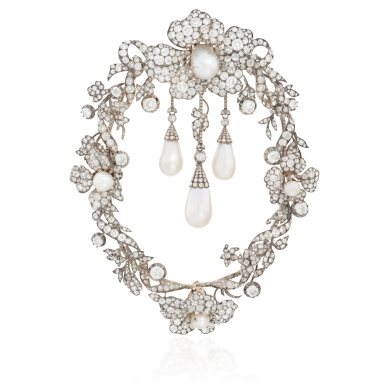Vienna 1900: An Imperial and Royal Collection
Vienna 1900: An Imperial and Royal Collection

From the Collection of Archduchess Marie Therese of Austria-Teschen, Duchess of Württemberg (1845-1927)
Exceptional and highly important natural pearl and diamond devant-de-corsage, circa 1865
Auction Closed
November 7, 12:14 PM GMT
Estimate
270,000 - 450,000 CHF
Lot Details
Description
From the Collection of Archduchess Marie Therese of Austria-Teschen, Duchess of Württemberg (1845-1927)
Exceptional and highly important natural pearl and diamond devant-de-corsage, circa 1865
Designed as a floral wreath set throughout with cushion-shaped and rose diamonds, the central flowerhead set with a drop-shaped natural pearl supporting three detachable drop-shaped pearl pendants capped by diamond-set surmounts, the stamen of each remaining flowerhead set with a button-shaped natural pearl, each flowerhead detachable, fitting for wearing the central flowerhead and three pendants as a brooch, two small diamonds deficient, fitted case stamped Emil Biedermann.
Accompanied by SSEF report no. 131219, stating that the pearls were found to be natural, saltwater; together with an appendix letter.
Archduchess Maria Immaculata of Austria-Tuscany, Duchess of Württemberg (1878-1968)
Philipp, Duke of Württemberg (1838-1917) offered this devant de corsage as a wedding gift to his bride Archduchess Marie Therese of Austria-Teschen, Duchess of Württemberg (1845-1927) on the occasion of their marriage in 1865.
Emil Biedermann
Emil Biedermann (1830-1900) was a renowned Viennese jeweller and Köchert's main competitor during the mid-nineteenth century.
Emil Biedermann ran a business founded by his grandfather Michael Lazar Biedermann (1769-1843). Michael Lazar was born in Pressburg (Bratislava) and apprenticed with an engraver in Vienna. In 1792, he adopted the surname Biedermann. By 1800, he had established his own jewellery store in Vienna and later branched out into textile manufacturing and banking.
His sons Joseph and Anton Biedermann took over the running of the jewellery business.
After the revolution of 1848, a young Emperor Franz Joseph jointly named Biedermann and Köchert crown jewellers, a position Biedermann would hold for the following twenty years. Michael Lazar Biedermann's daughter Regine married her first cousin Joseph Biedermann and they were the parents of Emil Biedermann who would lead the company through its most successful period during the mid-nineteenth century. Biedermann ceased activity in the early 1890s.
For decades Biedermann received important commissions from the Imperial family amongst which this elaborate devant de corsage undoubtedly stands out as one of his most ambitious creations.
